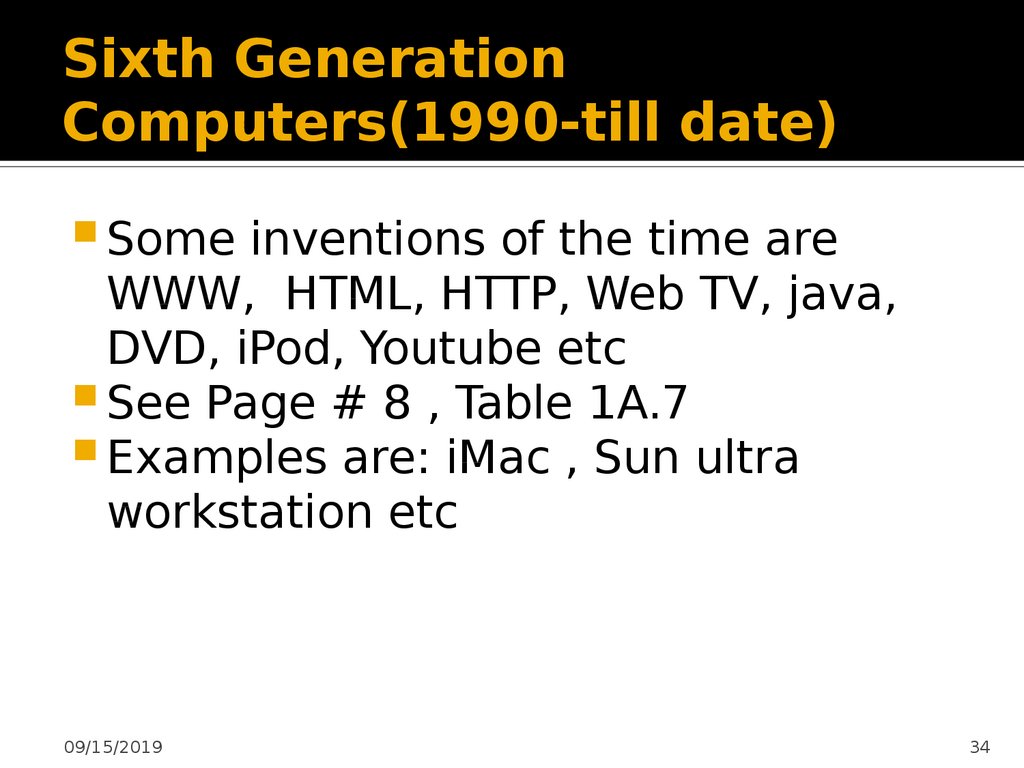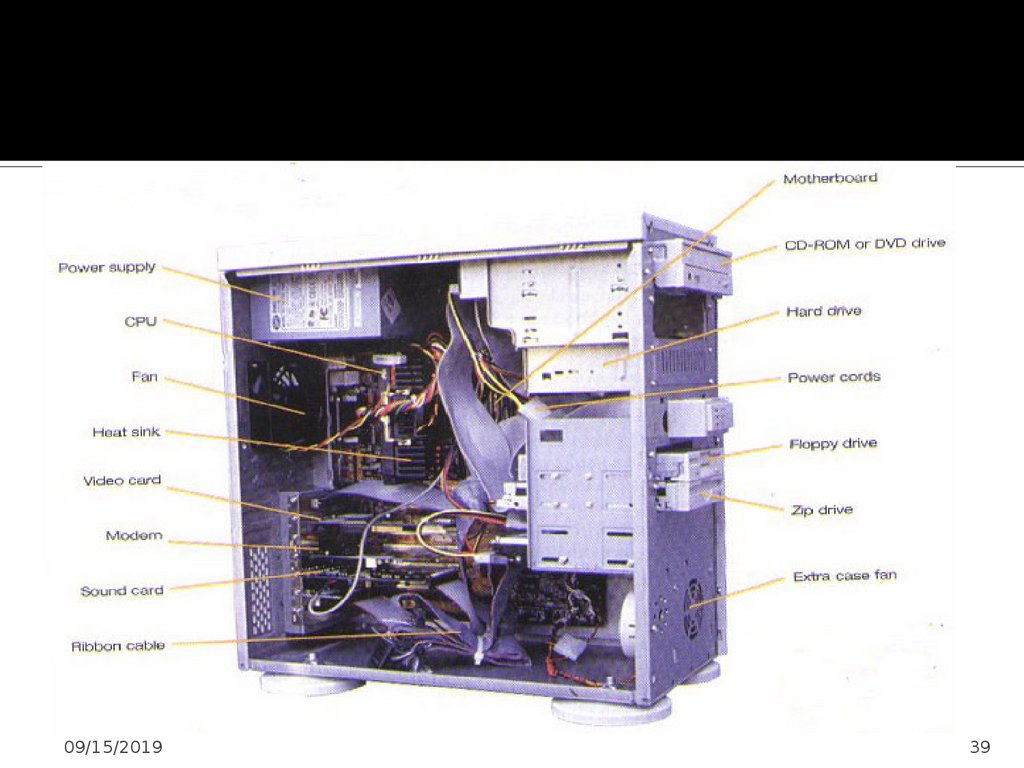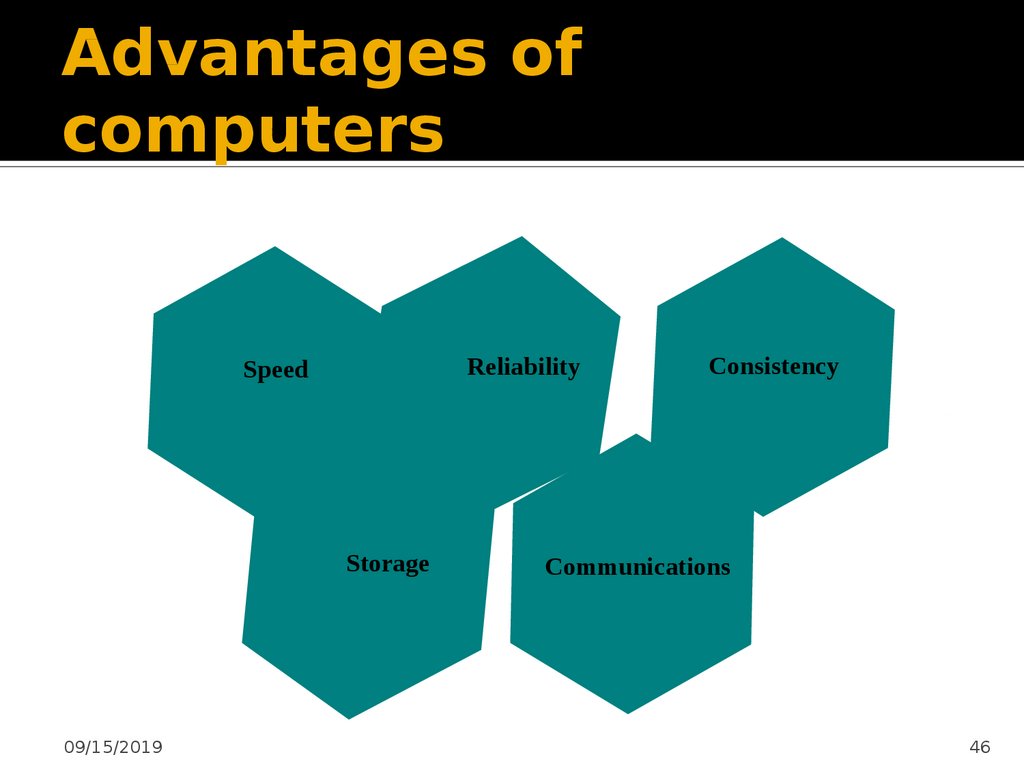Similar presentations:
Introduction to informational and communication technologies
1. Introduction to Informational and Communication Technologies
Lecture # 109/15/2019
1
2.
Informationand communication
technologies (ICT ) is the discipline
which considers modern methods
and means of communication of
people in a normal and professional
activities with the help of information
technologies to search , collection,
storage , processing and
dissemination of information.
09/15/2019
2
3.
Thematic plan№
Titles of lectures
1
Main directions of ICT development . ICT Standardization
2
Operation systems
3
Text processors and editors
4
Electronic tables
5
Database management systems
6
Local area network
7
Global networks
8
Social networks
9
Privacy and information security in ICT
10 Introduction to Web-technology
11 Tools for graphical representation of the information
12 Human-machine interaction
13 Multimedia technologies
14 SMART-тtechnologies
15 Е-technologies and the prospects of the ICT development
4. Definition of Information Technology
Defnition of InformationTechnology
Information
technology is the
technology that uses computing with
high speed communication links to
spread information from one place to
another.
Computer is a very important
component of information
technology
The world has become “global
village” due to advancement in IT.
09/15/2019
4
5. What is a Computer?
Anelectronic device that is programmed to
accept data, process data into useful
information and store it for later use
Computer consists of hardware and software
Software is a set of instructions that tells a
computer what to do
Hardware is the physical part of a computer
E.g. CPU, RAM, HDD.etc
Relationship between hardware and
software
09/15/2019
5
6.
09/15/20196
7. Few Basics
CPU09/15/2019
Computer
Hardware
Memory I/O Etc.
Software
Application
Software
System
Software
7
8. Types of Computers
Analog computersDigital computers
09/15/2019
8
9. Analog Computers
Ananalog computer
recognizes data as a
continuous measurement of a
physical property.
It has no state
Its output is usually displayed
on a meter or graphs.
Examples are Analog clock,
speed of a car, thermometer
etc
09/15/2019
9
10. Digital Computers
It works with numbersThey breaks all types of
information
into tiny units and use numbers to
represent those pieces of
information.
Everything is described in two states
i.e. either ON (1) or OFF (0).
They are very fast and have big
memory
09/15/2019
10
11. History and Generations of computers
The six generations of computers are:Mechanical era(1623-1900)
First generation electronic
computers(1937-1953)
Second generation (1954-1962)
Third generation (1963-1972)
Forth generation (1972-1984)
Fifth generation (1984-1990)
Sixth generation (1990 - present)
09/15/2019
11
12. Mechanical Era
Abacus(3000 BC)
It was used to perform addition,
subtraction, division and
multiplication. It consists of wooden
beads and calculation were
performed by moving these beads
properly.
09/15/2019
12
13.
Napier’sbone (17th century)
It was a cupboard multiplication
calculator
invented by john Napier.
It was used to perform difcult
multiplication operations to simple
addition of entries in a table
09/15/2019
13
14.
Pascaline(17th century)
It was invented by Blaise Pascal.
It was frst mechanical adding machine
It had a series of wheels with teeth
which could
be turned using hands.
09/15/2019
14
15.
DifferenceEngine and Analytical
Engine(1823 and 1833)
It was designed by Charles Babbage
who was English mathematician,
engineer, philosopher and inventor.
He originated the concept of the
programmable computer.
A general purpose computer
controlled by a list of instructions
09/15/2019
15
16.
Punchedcards (1890)
They were able to read information
that which have been punched into
the cards automatically
09/15/2019
16
17. First generation Electronic computers
Firstgeneration computers were used
during 1942-1955 .
They were based on Vacuum Tube
which was a glass (tube) that controlled
and amplifed the electronic signals
Consume more power with limited
performance
High cost
Uses assembly language – to prepare
programs. These were translated into
machine level language for execution.
09/15/2019
17
18.
Fixedpoint arithmetic was used
100 to 1000 fold increase in speed relative to the
earlier mechanical and relay based
electromechanical technology
Punched cards and paper tape were invented to
feed programs and data and to get results.
Magnetic tape / magnetic drum were used as
secondary memory
Mainly used for scientifc computations.
See page # 6, Table 1A.2
Examples are: UNIVAC, Havard Mark 1, ENIAC etc
09/15/2019
18
19.
09/15/201919
20. Second Generation (1955-1964)
BellLab invented the transistor – function
like
vacuum tubes but smaller, lower power
consumption, more reliable.
Transistor is a small device that transfer
electronic signals across a resister
Lower cost
Magnetic core memories were used as
main memory which is a random-access
nonvolatile memory
Magnetic tapes and magnetic disks were
used as secondary memory
Hardware for foating point arithmetic
operations was developed.
09/15/2019
20
21.
Indexregisters were introduced which increased
fexibility of programming.
High level languages such as FORTRAN, COBOL etc
were used - Compilers were developed to translate the
high-level program into corresponding assembly
language program which was then translated into
machine language.
Separate input-output processors were developed that
could operate in parallel with CPU.
Punched cards continued during this period also.
1000 fold increase in speed.
See Page# 6 , Table 1A.3
Examples are: TRADIC, IBM 704, LARC etc
09/15/2019
21
22.
09/15/201922
23. Third Generation (1963-1971)
Third Generation (19631971)Jack
Kilby developed Integrated Circuit
(IC)
An IC combined several electronic computers
on a small silicon chip
IBM introduced
System/360 – a highly confgurable,
highly backward compatible,
mainframe computer system.
Small Scale Integration and Medium Scale
Integration technology were implemented in
CPU, I/O processors etc.
Smaller & better performance
Comparatively lesser cost
Faster processors
09/15/2019
23
24.
In the beginning magnetic core memorieswere used. Later they were replaced by
semiconductor memories (RAM & ROM)
Introduced microprogramming
Microprogramming, parallel processing
(pipelining, multiprocessor system etc),
multiprogramming, multi-user system (time
shared system) etc were introduced.
Operating system software were introduced
Cache and virtual memories were introduced
09/15/2019
24
25.
Highlevel languages were standardized by
ANSI e.g.. ANSI FORTRAN, ANSI COBOL etc
Database management, multi-user
application, online systems like closed loop
process control, airline reservation,
interactive query systems, automatic
industrial control etc emerged during this
period.
See page # 7, Table 1A.4
Examples are: INTEL 4004, IBM SYSTEM/360
etc
09/15/2019
25
26.
09/15/201926
27. Forth generation (1972-1984)
Microprocessorswere introduced as CPU–
Complete processors and large section of main
memory could be implemented in a single chip
Tens of thousands of transistors can be placed in
a single chip (VLSI design implemented)
CRT screen, laser & ink jet printers, scanners etc
were developed.
Semiconductor memory chips were used as the
main memory.
Secondary memory was composed of hard disks
– Floppy disks & magnetic tapes were used for
backup memory
09/15/2019
27
28.
Parallelism,pipelining cache memory and
virtual memory were applied in a better way
LAN and WANS were developed (where desktop
work stations interconnected)
Introduced C language and Unix OS
Introduced Graphical User Interface
Less power consumption
High performance, lower cost and very compact
Much increase in the speed of operation
Examples are Apple Macintosh and IBM PC
See Page # 7, Table 1A.5
09/15/2019
28
29.
09/15/201929
30. Fifth Generation (1983-1990)
Fifth Generation (19831990)Computers
based on artifcial intelligence are available
Computers use extensive parallel processing, multiple
pipelines, multiple processors etc
Massive parallel machines and extensively distributed system
connected by communication networks fall in this category.
Introduced ULSI (Ultra Large Scale Integration) technology –
Intel’s Pentium 4 microprocessor contains 55 million transistors
millions of components on a single IC chip.
Superscalar processors, Vector processors, SIMD processors, 32
bit micro controllers and embedded processors, Digital Signal
Processors (DSP) etc have been developed.
Memory chips up to 1 GB, hard disk drives up to 180 GB and
optical disks up to 27 GB are available (still the capacity is
increasing)
Object oriented language like JAVA suitable for internet
programming has been developed.
09/15/2019
30
31.
Portable note book computers introducedStorage technology advanced – large
main memory and disk storage available
Introduced World Wide Web. (and other
existing applications like e-mail, e
Commerce, Virtual libraries/Classrooms,
multimedia applications etc.)
New operating systems developed –
Windows 95/98/XP/…, LINUX, etc.
09/15/2019
31
32.
Gothot pluggable features – which
enable a failed component to be
replaced with a new one without the
need to shutdown the system,
allowing the uptime of the system to
be very high.
The recent development in the
application of internet is the Grid
technology which is still in its
upcoming stage.
09/15/2019
32
33.
09/15/201933
34. Sixth Generation Computers(1990-till date)
Someinventions of the time are
WWW, HTML, HTTP, Web TV, java,
DVD, iPod, Youtube etc
See Page # 8 , Table 1A.7
Examples are: iMac , Sun ultra
workstation etc
09/15/2019
34
35. Computers Systems and its Components
Input DevicesOutput devices
System Unit
Storage devices
Communication devices
09/15/2019
35
36. Input devices
Thedevices that are used to enter
data and instructions into the
computers
Most commonly used input devices
are Keyboard and Mouse
09/15/2019
36
37. Output Devices
Outputdevices are used
to display processed data
to the user
Most commonly used
output devices are
Monitor, Printer and
speakers
Hard Copy is paper copy
– tangible
Soft copy is intangible
09/15/2019
37
38. System Unit
Itsa box that contains different
components of a computer system.
All electronic components in the
system unit are connected to
motherboard
Important components of system
units are:
Central processing Unit(Processor)
Memory
09/15/2019
38
39.
09/15/201939
40. Storage Devices
Theseare used to store data
permanently even when the
computer is turned off
It is non volatile memory
Examples:
Floppy Disk, Hard disk, CD ROM
09/15/2019
40
41. Communication devices
Acommunication device is a
hardware component that enables a
computer to send and receive data,
instructions and information to and
from one or more computers.
A widely used communication device
is Modem
Wired media
Wireless media
09/15/2019
41
42. Modulation and Demodulation
ModulationConversion from Digital signals to
Analog signals
Demodulation
Conversion from Analog signals
to Digital signals
09/15/2019
42
43. Computers in society
HomeEducation
Small
business
Industry
Government
Health care
Banking
Communication
Police Department
Retail
09/15/2019
43
44. Information Processing cycle
DataA collection of raw facts and
fgures is called data. It may consist
of numbers, characters, symbols or
pictures etc
Information
Processed data is called
information. It is more meaningful
than data.
09/15/2019
44
45. Information Processing Cycle
Datais collected and given to the computer
for processing
Computer process data to the required
information
The information is given to the user as output
Information is stored in the computer for
further use
09/15/2019
45
46. Advantages of computers
ReliabilitySpeed
Storage
09/15/2019
Consistency
Communications
46
47. Disadvantages of computers
Violation ofPrivacy
Impact on
Labor Force
09/15/2019
Public Safety
Health Risks
Impact on
Environment
47
48.
Main Literature:•June J. Parsons, New Perspectives on Computer Concepts 18th Edition—
Comprehensive, Thomson Course Technology, a division of Thomson
Learning, Inc Cambridge, MA, COPYRIGHT © 2016; ISBN-10: 1-42390610-1, ISBN-13: 978-1-4239-0610-0.
•Reema Thareja Fundamentals of Computers. – Oxford University press:
Oxford, 2014. - 288p
•George Beekman. Computer Confluence: Exploring Tomorrow's
Technology. ISBN 0130661880, 9780130661883. Prentice Hall, 2003
•Симонович С.В. и др. Информатика. Базовый курс: учебное пособие
для высших технических учебных заведений. – СПб.: Питер, 2011. –
639 с.
49.
Additional literature:•Thomas M. Connolly, et al. Database Systems: A practical approach to Design, Implementation,
and Management. 4th Edition ISBN: 0321210255 Addison-Wesley, 2004
•H. L. Capron. Computers: Tools for an Information Age. Addison-Wesley, 1998.
•Roqers Y., H. Sharp, J. Preece. Interaction design beyond human - computer interaction - Third
Edition.- Italy: WILEY & Sons Ltd, 2011.- 585 р.
•Ducket, J. Beginning Web Programming with HTML, XHTML, and CSS: 2th ed. / Jon Ducket.U.S.A: Wiley Publishing. Inc, 2008.- 739с. ISBN 978-1-0-470-25931-3.
•Stephen P Borgatti, Martin G. Everett, Jeffrey C. Johnson Analyzing Social Networks Paperback,
2013
•Уша Рани Вьясулу Редди. Серия учебников по ИКТР для молодежи. Учебник 1: Введение в
ИКТ для развития. UN-APCICT/ESCAP 2011
•Дейтел Х. М., Дейтел П. Дж., Чофнес Д. Р. Операционные системы. Часть 1. Основы и
принципы. – М.: Бином-Пресс, 2011. – 677 c.
•Ярочкин В.И. Информационная безопасность: Учебник для вузов. – М.: Акад. Проект, 2008.
– 544 c.
•Голицына О.Л. Базы данных: Учебное пособие. – М.: Форум, 2012. – 400 c.
•Keith Worden, W.A. Bullough, J. Haywood. Smart Technologies. World Scientific Pub Co Inc
(April 14, 2003)


















































 informatics
informatics








